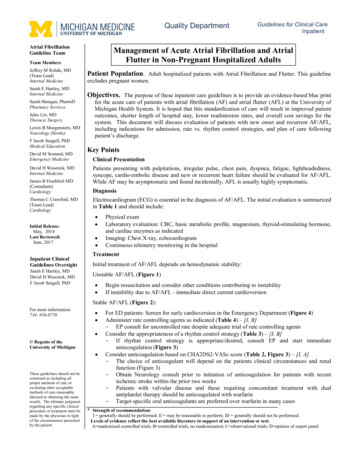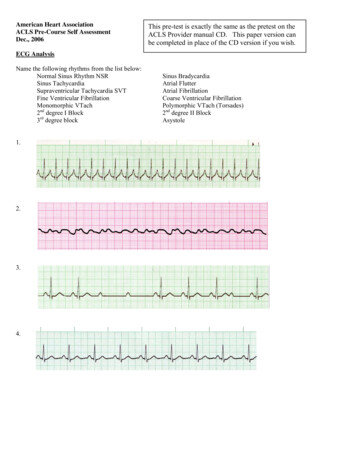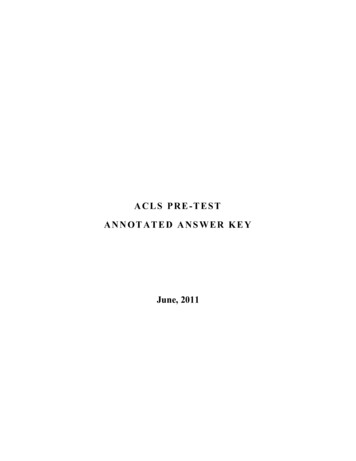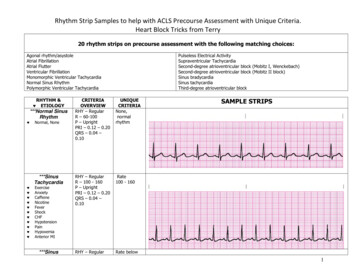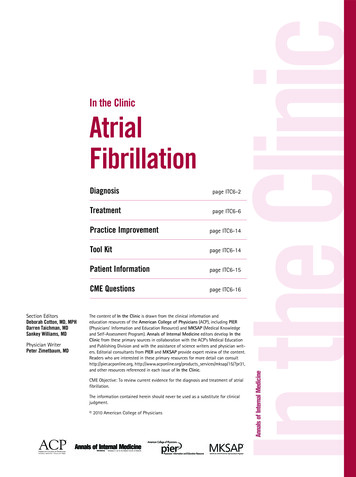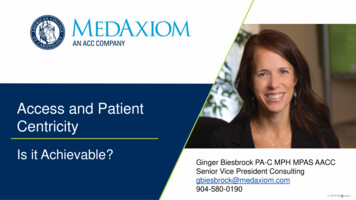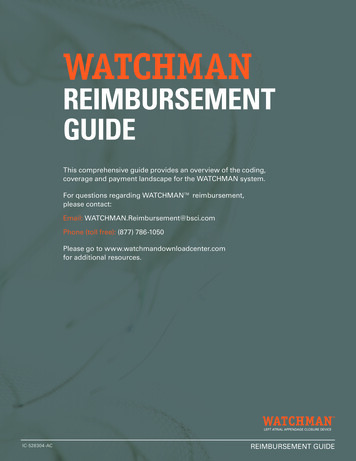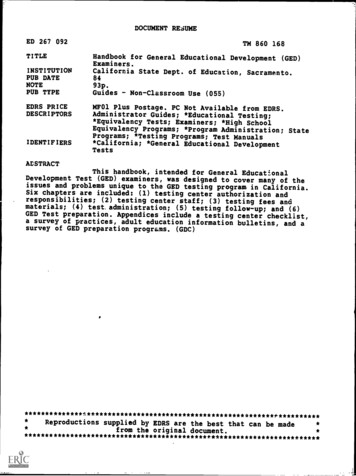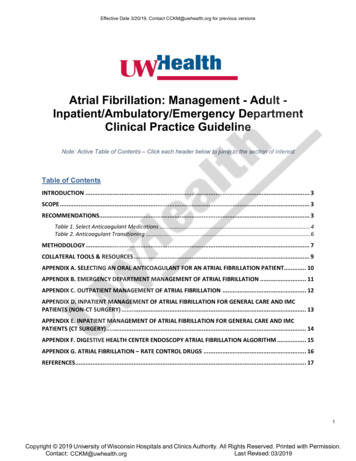
Transcription
Effective Date 3/20/19. Contact CCKM@uwhealth.org for previous versionsAtrial Fibrillation: Management - Adult Inpatient/Ambulatory/Emergency DepartmentClinical Practice GuidelineNote: Active Table of Contents – Click each header below to jump to the section of interestTable of ContentsINTRODUCTION . 3SCOPE . 3RECOMMENDATIONS. 3Table 1. Select Anticoagulant Medications . 4Table 2. Anticoagulant Transitioning . 6METHODOLOGY . 7COLLATERAL TOOLS & RESOURCES . 9APPENDIX A. SELECTING AN ORAL ANTICOAGULANT FOR AN ATRIAL FIBRILLATION PATIENT. 10APPENDIX B. EMERGENCY DEPARTMENT MANAGEMENT OF ATRIAL FIBRILLATION . 11APPENDIX C. OUTPATIENT MANAGEMENT OF ATRIAL FIBRILLATION . 12APPENDIX D. INPATIENT MANAGEMENT OF ATRIAL FIBRILLATION FOR GENERAL CARE AND IMCPATIENTS (NON-CT SURGERY) . 13APPENDIX E. INPATIENT MANAGEMENT OF ATRIAL FIBRILLATION FOR GENERAL CARE AND IMCPATIENTS (CT SURGERY). 14APPENDIX F. DIGESTIVE HEALTH CENTER ENDOSCOPY ATRIAL FIBRILLATION ALGORITHM . 15APPENDIX G. ATRIAL FIBRILLATION – RATE CONTROL DRUGS . 16REFERENCES. 171Copyright 2019 University of Wisconsin Hospitals and Clinics Authority. All Rights Reserved. Printed with Permission.Contact: LeeVermeulen, CCKM@uwhealth.orgLast Revised: 03/2019CCKM@uwhealth.org
Effective Date 3/20/19. Contact CCKM@uwhealth.org for previous versionsContent Expert(s):Name: Jennifer Wright, MD - CardiologyPhone Number: (608) 265-1038Email Address: jmwright@medicine.wisc.eduContact for Changes:Center for Clinical Knowledge Management (CCKM)Email Address: CCKM@uwhealth.orgWorkgroup Members:Anne M. O’Connor, MD- CardiologyCraig January, MD – CardiologyKathleen Wackerle, NP – CardiologyStephanie Kraus, RN – CardiologyMichael Safa, MD – Emergency MedicinePrabhav Kenkre, MD – Hospital MedicineDavid Yang, MD - LaboratorySatoru Osaki, MD – Cardiac SurgeryMargaret Murray, RN – Cardiac SurgeryMichael Weber, MD – Family MedicineAnne Rose, PharmD – Anticoagulation StewardshipCarin Bouchard, PharmD – Drug Policy ProgramTheodore Berei, PharmD – Inpatient ServicesMichael Licari, PharmD – Inpatient PharmacyThomas Bugliosi, MD – UnityPoint Health MeriterPaul Hick, DO – UnityPoint Health Meriter – Emergency MedicineThomas Bugliosi, Unitypoint Health Meriter – Hospital MedicineMarissa Collard, PharmD – Unitypoint Health Meriter- Inpatient PharmacyReviewer(s):Joanna Ruchala, MD-Internal MedicineCommittee Approval(s):Clinical Knowledge Management (CKM) Council (02/28/19)2Copyright 2019 University of Wisconsin Hospitals and Clinics Authority. All Rights Reserved. Printed with Permission.Contact: LeeVermeulen, CCKM@uwhealth.orgLast Revised: 03/2019CCKM@uwhealth.org
Effective Date 3/20/19. Contact CCKM@uwhealth.org for previous versionsIntroductionAtrial fibrillation (AF) is a common cardiac rhythm disturbance and increases in prevalence withadvancing age. Up to 12% of patients between 75 to 84 years of age have atrial fibrillation.1 AFis associated with a 5-fold increased risk of stroke2, a 3-fold risk of heart failure3-5, and a 2-foldincreased risk of both dementia6 and mortality.2ScopeIntended User(s): Physicians, Advanced Practice Providers, Registered Nurses, Pharmacists,Cardiac Rehabilitation TherapistsObjective(s): To provide evidence-based recommendations for the most effective therapeutictreatment and management of atrial fibrillation (AF) across all care settings (inpatient,ambulatory and the Emergency Department.)Target Population: Adult patients diagnosed with atrial fibrillation or atrial flutter. Atrial flutter(typical) may be amendable to ablation; providers should have a low threshold to consultCardiovascular Medicine/Electrophysiology early in clinical course.Clinical Questions Considered: When is antithrombotic therapy recommended in nonvalvular AF patients? Which patients are eligible for cardioversion in the Emergency Department setting? When should Cardiology be consulted for a patient with atrial fibrillation being managed inthe primary care setting?RecommendationsUW Health has agreed to endorse the 2019 AHA/ACC/HRS Focused Update and the 2014AHA/ACC/HRS Guideline for the Management of Patients with Atrial Fibrillation.7,8In addition, listed below are tables and algorithms based on the 2019 AHA/ACC/HRS guidelinethat were developed to aid in clinician management of atrial fibrillation patients.Drug related tables Table 1 provides dosing and drug information on select oral anticoagulant medications Table 2 gives guidance on transitioning between anticoagulant drugs.Algorithms Appendix A- Selecting an Oral Anticoagulant for an Atrial Fibrillation Appendix B- Emergency Department Management of Atrial Fibrillation Appendix C- Outpatient Management of Atrial Fibrillation Appendix D- Inpatient Management of Atrial Fibrillation: Management for General Careand Intermediate Medical Care (IMC) – Non- Cardiothoracic (CT) Surgery Appendix E- Inpatient Management Atrial Fibrillation Algorithm for General Care andIMC (CT Surgery) Appendix F- Digestive Health Center Endoscopy Atrial Fibrillation Algorithm Appendix G- Atrial Fibrillation – Rate Control Drugs3Copyright 2019 University of Wisconsin Hospitals and Clinics Authority. All Rights Reserved. Printed with Permission.Contact: LeeVermeulen, CCKM@uwhealth.orgLast Revised: 03/2019CCKM@uwhealth.org
Effective Date 3/20/19. Contact CCKM@uwhealth.org for previous versionsTable 1. Select Anticoagulant Medications 9-13 14DrugDosingCrCl(mL/min) 15Apixaban(Eliquis )Factor Xainhibitor5 mg BID2.5 mg BID with concomitantuse of strong CYP3A4 andP-gp inhibitors2.5 mg BID if 2 of thefollowing:- age 80 years- body weight 60 kg- SCr 1.5 mg/dL 15(not on HD) 95Factor Xainhibitor Active bleeding, Hypersensitivity toapixaban Major regional orlumbar blockanalgesia Pregnancy50-952.5 mg BID if either:- age 80 years- body weight 60 kgAvoid useAvoid use60 mg once dailyFactor XainhibitorRivaroxaban(Xarelto )Contraindications Drug Interactions5 mg BID 15 (on HD)Edoxaban(Savaysa )Suggested Dose15-5030 mg once daily 15Avoid use 5020 mg once daily15-5015 mg once daily 15Avoid use Active pathologicalbleeding Pregnancy Strong CYP3A4 inhibitors (e.g.azole antifungals, nicardipine,ritonavir) may increase the serumconcentrations Strong CYP3A4 inducers (e.g.carbamazepine, nafcillin,phenobarbital, phenytoin, rifampin)may decrease serum concentrations P-gp inhibitors (e.g. amiodarone,cyclosporine, ketoconazole,quinidine, verapamil) may increasethe serum concentration P-gp inducers (e.g. carbamazepine,dexamethasone, phenytoin,prazosin, rifampin) may decreasethe serum concentration Strong CYP3A4 inhibitors (e.g. azoleantifungals, nicardipine, ritonavir)may increase the serumconcentrations Strong CYP3A4 inducers (e.g.carbamazepine, nafcillin,phenobarbital, phenytoin, rifampin)may decrease serum concentrations P-gp inhibitors (e.g. amiodarone,cyclosporine, ketoconazole,quinidine, verapamil) may increasethe serum concentration P-gp inducers (e.g. carbamazepine,dexamethasone, phenytoin,prazosin, rifampin) may decreasethe serum concentrationNotes Avoid use in nursingAdverse reactions includebleeding, nausea, anemiaincreased transaminases Black Box warning: Increasedrisk of ischemic events whenstopped without adequateanticoagulation with analternative agentBlack Box warning: Epidural orspinal hematomas may occurin those who are receivingneuraxial anesthesia or areundergoing spinal puncture. Adverse reactions includebleeding events, anemia,abnormal hepatic function tests Black Box warning: Increasedrisk of ischemic events whenstopped without adequateanticoagulation with analternative agentBlack Box warning: Epidural orspinal hematomas may occurin those who are receivingneuraxial anesthesia or areundergoing spinal puncture.Black Box warning (foredoxaban only): CrCl 95mL/min; reduced efficacy innon-valvular AF4Copyright 2019 University of Wisconsin Hospitals and Clinics Authority. All Rights Reserved. Printed with Permission.Contact: LeeVermeulen, CCKM@uwhealth.orgLast Revised: 03/2019CCKM@uwhealth.org
Effective Date 3/20/19. Contact CCKM@uwhealth.org for previous versionsTable 1. Anticoagulant Dosing Table (continued)DrugDosingCrCl(mL/min)Suggested Dose 3075 mg BID withconcomitant use ofP-gp inhibitorDabigatran(Pradaxa )Direct thrombininhibitor150 mg BID75 mg BID15-30Avoid use if concomitantuse of P-gp inhibitorContraindications Drug Interactions Active bleedingHypersensitivityto dabigatranMajor regional orlumbar blockanalgesiaMechanicalprosthetic heartvalvesPregnancy P-gp inhibitors (e.g. amiodarone,cyclosporine, ketoconazole,quinidine, verapamil) may increasethe serum concentration P-gp inducers (e.g. carbamazepine,dexamethasone, phenytoin,prazosin, rifampin) may decreasethe serum concentrationNotes 15AspirinCOX-inhibitor81 mg once daily Warfarin(Coumadin )Vitamin KAntagonistNoadjustmentneeded forrenaldysfunctionDose varies based onpatient-specific factorsBlack Box warningIncreased risk of ischemicevents when stopped withoutadequate anticoagulation withan alternative agentBlack Box warning: Epidural orspinal hematomas may occurin those who are receivingneuraxial anesthesia or areundergoing spinal puncture.Avoid useNoadjustmentneeded forrenaldysfunctionAdverse reactions includebleeding, dyspepsia, anemiaincreased ALTDyspepsia may be minimizedby taking with foodHypersensitivityto salicylatesRhinitisNasal polypsInherited oracquired bleedingdisordersPatients 16years for viralinfectionsPregnancy (can besafely used whenbreastfeeding) Strong CYP3A4 inhibitors (e.g. azoleantifungals, nicardipine, ritonavir)may increase the serumconcentrations Strong CYP3A4 inducers (e.g.carbamazepine, nafcillin,phenobarbital, phenytoin, rifampin)may decrease serum concentrations P-gp inhibitors (e.g. amiodarone,cyclosporine, ketoconazole,quinidine, verapamil) may increasethe serum concentration P-gp inducers (e.g. carbamazepine,dexamethasone, phenytoin,prazosin, rifampin) may decreasethe serum concentration Adverse reactions includedyspepsia, nausea, andbleeding events Adverse reactions includeincreased risk forbleeding/bleeding events; lesscommon hepatitis, skinnecrosis, and “purple toe”syndrome Potential food interactions(e.g., alcohol, foods high invitamin K such as green leafyvegetables) Black Box warning:Can cause major or fatalbleedingCopyright 2019 University of Wisconsin Hospitals and Clinics Authority. All Rights Reserved. Printed with Permission.Contact: LeeVermeulen, CCKM@uwhealth.orgLast Revised: 03/2019CCKM@uwhealth.org5
Table 2. Anticoagulant Transitioning10-13SwitchProcedureWarfarin DabigatranWarfarin RivaroxabanWarfarin ApixabanWarfarin EdoxabanDabigatran WarfarinRivaroxaban WarfarinApixaban WarfarinEdoxaban WarfarinUnfractionated heparin(UFH) Direct oral anticoagulant (DOAC)DOAC IV UFH orenoxaparinEffective Date 3/20/19. Contact CCKM@uwhealth.org for previous versionsStop warfarin, start dabigatran when INR 2.0Stop warfarin, start rivaroxaban when INR 3.0Stop warfarin, start apixaban when INR 2.0Stop warfarin, start edoxaban when INR 2.5Dabigatran affects the INR – measuring INRs during co-administration may not be useful for determining an appropriate dose of warfarin Start warfarin while patient is still taking dabigatran Stop dabigatran 1-3 days later, depending on INR and CrCl If CrCl 50 mL/min: initiate warfarin 3 days prior to discontinuation of dabigatran If CrCl 31-50 mL/min: initiate warfarin 2 days before discontinuation of dabigatran If CrCl 15-30 mL/min: initiate warfarin 1 day before discontinuation of dabigatranRivaroxaban affects the INR – measuring INRs during co-administration may not be useful for determining an appropriate dose of warfarin Initiate warfarin and a parenteral anticoagulant 24 hours after discontinuation of rivaroxaban*Apixaban affects the INR – measuring INRs during co-administration may not be useful for determining an appropriate dose of warfarin If continuous anticoagulation is necessary, discontinue apixaban and begin both a parenteral anticoagulant with warfarin when thenext dose of apixaban is due; discontinue parenteral anticoagulant when INR reaches an acceptable range*Oral option: For patients receiving 60 mg of edoxaban, reduce dose to 30 mg and begin warfarin concomitantly. For patients receiving 30 mgof edoxaban, reduce the dose to 15 mg and begin warfarin concomitantly. INR must be measured at least weekly and just prior to the daily dose of edoxaban to minimize the influence of edoxaban on INRmeasurements. Once a stable INR 2 is achieved, edoxaban should be discontinued and the warfarin continued.Parenteral option: Discontinue edoxaban and administer a parenteral anticoagulant (UFH or enoxaparin) and warfarin at the time of the nextscheduled edoxaban dose. Once a stable INR 2 is achieved, edoxaban should be discontinued and warfarin continued. Start dabigatran, rivaroxaban, or apixaban at the time of heparin discontinuation Start edoxaban 4 hours after heparin discontinuationDabigatran: If CrCl 30 mL/min, start UFH or enoxaparin 12 hours after the last dose of dabigatran If CrCl 30 mL/min, consider starting UFH or enoxaparin 24 hours after the last dabigatran dose, based on the clinical interpretationof the patients bleeding and thrombosis riskRivaroxaban: Start UFH or enoxaparin 24 hours after the last rivaroxaban dose, based on the clinical interpretation of the patients bleeding andthrombosis riskApixaban: Start UFH or enoxaparin 12 hours after the last apixaban doseEdoxaban: Start UFH or enoxaparin at the time of the next dose of edoxaban*Overall risk stratification should focus on the patient’s risk of thromboembolism since the consequences of a thromboembolic event are more likelyto have serious, lasting effects compared to consequences of major bleeding. It is recommended to provide continuous therapeutic anticoagulationfor patients with a recent stroke or TIA (within 3 months). Note that not all patients will require bridging with a parenteral anticoagulant.6Copyright 2019 University of Wisconsin Hospitals and Clinics Authority. All Rights Reserved. Printed with Permission.Contact: LeeVermeulen, CCKM@uwhealth.orgLast Revised: 03/2019CCKM@uwhealth.org
Effective Date 3/20/19. Contact CCKM@uwhealth.org for previous versionsDisclaimerClinical practice guidelines assist clinicians by providing a framework for the evaluation andtreatment of patients. This guideline outlines the preferred approach for most patients. It is notintended to replace a clinician’s judgment or to establish a protocol for all patients. It isunderstood that some patients will not fit the clinical condition contemplated by a guideline andthat a guideline will rarely establish the only appropriate approach to a problem.MethodologyDevelopment ProcessEach guideline is reviewed and updated a minimum of every 3 years. All guidelines aredeveloped using the guiding principles, standard processes, and styling outlined in the UWHealth Clinical Practice Guideline Resource Guide. This includes expectations for workgroupcomposition and recruitment strategies, disclosure and management of conflict of interest forparticipating workgroup members, literature review techniques, evidence grading resources,required approval bodies, and suggestions for communication and implementation.Methods Used to Collect the Evidence:The following criteria were used by the guideline author(s) and workgroup members to conductelectronic database searches in the collection of evidence for review.Literature Sources: Electronic database search (e.g., PubMed)Time Period: September 2018 to February 2019The following is a list of various search terms that were used individually or in combination witheach other for literature searches on PubMed: Atrial fibrillation, guideline, management,Emergency, anticoagulation.Methods to Select the Evidence:Literary sources were selected with the following criteria in thought: English language,publication in a MEDLINE core clinical journal and strength of expert opinion (e.g., professionalorganization or society).Methods Used to Formulate the Recommendations:The workgroup members agreed to adopt recommendations developed by externalorganizations and/or created recommendations internally via a consensus process usingdiscussion of the literature and expert experience/opinion. If issues or controversies arosewhere consensus could not be reached, the topic was escalated appropriately per the guidingprinciples outlined in the UW Health Clinical Practice Guideline Resource Guide.Methods Used to Assess the Quality of the Evidence/Strength of the Recommendations:Recommendations developed by external organizations maintained the evidence gradeassigned within the original source document and were adopted for use at UW Health.Internally developed recommendations, or those adopted from external sources without anassigned evidence grade, were evaluated by the guideline workgroup using an algorithmadapted from the Grading of Recommendations Assessment, Development and Evaluation(GRADE) methodology (see Figure 1).7Copyright 2019 University of Wisconsin Hospitals and Clinics Authority. All Rights Reserved. Printed with Permission.Contact: LeeVermeulen, CCKM@uwhealth.orgLast Revised: 03/2019CCKM@uwhealth.org
Effective Date 3/20/19. Contact CCKM@uwhealth.org for previous versionsFigure 1. GRADE Methodology adapted by UW HealthRating Scheme for the Strength of the Evidence/Recommendations:GRADE Ranking of EvidenceHighWe are confident that the effect in the study reflects the actual effect.ModerateWe are quite confident that the effect in the study is close to the true effect,but it is also possible it is substantially different.LowThe true effect may differ significantly from the estimate.Very LowThe true effect is likely to be substantially different from the estimatedeffect.GRADE Ratings for Recommendations For or Against PracticeStrong (S)Generally should be performed (i.e., the net benefit of the treatment isclear, patient values and circumstances are unlikely to affect the decision.)Conditional (C)May be reasonable to perform (i.e., may be conditional upon patient valuesand preferences, the resources available, or the setting in which theintervention will be implemented.)Recognition of Potential Health Care Disparities: Disparities have been identified in the waypatients of different racial groups are managed and in the way patients with different types ofatrial fibrillation (AF) are treated. In cross-sectional analyses of United Kingdom patients, eligiblepatients with paroxysmal atrial fibrillation were half as likely to be treated with anticoagulants in2000 as patients with other types.15 In 2015, this treatment gap improved, but still illustrated thatparoxysmal AF patients were around 20% less likely to be prescribed anticoagulant therapy. 15Racial variations in the diagnosis and management of AF are also recognized in the literature. 168Copyright 2019 University of Wisconsin Hospitals and Clinics Authority. All Rights Reserved. Printed with Permission.Contact: LeeVermeulen, CCKM@uwhealth.orgLast Revised: 03/2019CCKM@uwhealth.org
Effective Date 3/20/19. Contact CCKM@uwhealth.org for previous versionsCollateral Tools & ResourcesThe following collateral tools and resources support staff execution and performance of theevidence-based guideline recommendations in everyday clinical practice.Metrics Describe metrics which could be used to assess compliance with the stated recommendations or toProportion of patients discharged from Emergency Department vs. admitted following implementationof ED Algorithm Number of patients which receive follow-up within 48 hours following discharge from EmergencyDepartmenteConsultseConsult to Cardiology – Atrial FibrillationGuidelines1. Hypertension – Adult – Inpatient/Ambulatory2. Heart Failure – Adult – Inpatient/AmbulatoryOrder Sets & Smart SetsIP – Atrial Fibrillation – Initial Onset – Adult – Supplemental [2170]ED – Clinical Decision Unit – Atrial Fibrillation [####]Patient Resources1. Health Facts For You #6252: Atrial Fibrillation (A-Fib)2. Health Facts For You #6900: Warfarin (Coumadin, Jantoven) (English)3. Health Facts For You #7085: Warfarin (Coumadin, Jantoven) (Spanish)4. Healthwise: Atrial Fibrillation5. Healthwise: Atrial Fibrillation: Cardioversion or Medicines: Deciding AboutPolicies1. UWHC Policy 1.38- Elective Direct Current (DC) Cardioversion – Adult & Pediatric9Copyright 2019 University of Wisconsin Hospitals and Clinics Authority. All Rights Reserved. Printed with Permission.Contact: LeeVermeulen, CCKM@uwhealth.orgLast Revised: 03/2019CCKM@uwhealth.org
Effective Date 3/20/19. Contact CCKM@uwhealth.org for previous versionsAppendix A. Selecting an Oral Anticoagulant for an Atrial Fibrillation Patient 8,17-19CHA2DS2VASc ScoreFactorsCongestive Heart FailureHypertensionAge 75Diabetes MellitusStroke/TIA/ThromboembolismVascular Disease(MI, PAD, aortic plaque)Age 65-74Sex Category – FemaleScoringPoints11212111No anti-thrombotictherapy 1 non-sex CHA2DS2-VASc riskConsiderfactorsanticoagulationOral 2 CHA2DS2-VASc risk factorsanticoagulationrecommendedFor patients with non-valvular AF with highCHA2DS2-VASc score and who are at high risk forbleeding/not candidate for long-term anticoagulation, consider referral for percutaneous leftatrial appendage closure device program.0 in men, 1 in womenHAS-BLED ScoreFactorsHypertension (SBP 160 mmHg)Abnormal lab values Creatinine 2.26 mg/dL Bilirubin 2x the upper limit of normal (ULN)and AST/ALT/AP 3x ULNStroke historyBleeding history or predispositionLabile INRs: Time in Therapeutic Range 60%Elderly: 65 yearsDrugs EtOH abuse ASA or NSAID useScoringScore 0-1: Low riskScore 2: Moderate riskScore 3: High riskHigh bleed risk considerations:- Optimize blood pressure control- Check INRs frequently- Utilize anticoagulation clinic- Focus on fall prevention- Utilize direct oral anti-coagulant (DOAC)Patient diagnosed withatrial fibrillationAnymechanical valve or moderateto severe mitral stenosis ?YESUse warfarinNOCalculate patient sCHA2DS2-VASc andHAS-BLED scoresAnticoagulationtherapy is indicatedbased on CHA2DS2VASc?Treat as clinicallyindicatedNOYESCrCl 15 mL/min?Patient Use warfarinHistory of GIbleed?YESUse apixaban or warfarin*NOAge 75 years?YESUse apixaban,rivaroxaban, orwarfarin*NOUse apixaban, dabigatran,rivaroxban, or warfarin**Based on the 2019 ACC/AHA Focused Update, direct oral anticoagulants(e.g., apixaban) are recommended over warfarin.Direct Oral Anticoagulant MonitoringCr (w/CrCl)Hgb/PltsALTBilirubinCrCl: 15-29 mL/minBaseline and every3 monthsCrCl: 30-60 mL/min or Age 75 yearsCrCl: 60 mL/minBaseline, and at 3,6, and 12 months for 1stBaseline, and at 3,6, and 12 months for 1st year, thenyear, then every 6 months thereafterannually thereafterBaseline, and at 3,6, and 12 months for 1st year, then annually thereafter (if stable)Baseline and every 12 months thereafter (if stable)Baseline and every 12 months thereafter (if stable)***Lab results that fall outside of normal limits should be repeated at least every 3-6 months.***10Copyright 2019 University of Wisconsin Hospitals and Clinics Authority. All Rights Reserved. Printed with Permission.Contact: LeeVermeulen, CCKM@uwhealth.orgLast Revised: 03/2019CCKM@uwhealth.org
Effective Date 3/20/19. Contact CCKM@uwhealth.org for previous versionsAppendix B. Emergency Department Management of Atrial Fibrillation8,14,2011Copyright 2019 University of Wisconsin Hospitals and Clinics Authority. All Rights Reserved. Printed with Permission.Contact: LeeVermeulen, CCKM@uwhealth.orgLast Revised: 03/2019CCKM@uwhealth.org
Effective Date 3/20/19. Contact CCKM@uwhealth.org for previous versionsAppendix C. Outpatient Management of Atrial Fibrillation8,14CONSIDER EARLY CONSULTATION WITH CARDIOLOGYIf any of the following are present, recommend Cardiologyconsult: Concern for tachycardia-bradycardia syndrome (sinus rate 50bpm, unable to titrale AV nodal agent due to slow sinusrates) Abnormal LV function/concern for tachycardia mediatedcardiomyopathy Typical atrial flutter Significant valve disease (moderate or greater MS, MR, AS, AR)AV NODAL BLOCKING THERAPYMetoprolol Metoprolol is 1st line unless prior intolerance or severe asthma Initial dosing: Metoprolol tartrate 25 mg PO twice daily (orsuccinate 50 mg daily) If already taking metoprolol, add above amount to total dailydose to a maximumof 200 mg/day; if already at 200 mg/day metoprolol, adddiltiazem Titrate accordingly for goal heart rate average 80 bpm in AFIBand sinus rhythm 50Diltiazem Diltiazem is 2nd line therapy Initial dosing: Long acting formulation 120 mg daily (24 hr ERformulation) If already taking diltiazem, add above amount to total dailydoseMODIFIABLE RISK FACTORS FOR AFIB Screen for obstructive sleep apnea (OSA); if symptomssuggested of OSA, refer to Sleep medicine If overweight, counsel on importance of weight loss; considerreferral to Preventive medicine for dietician and exerciseprescription If sedentary, counsel on importance of light to moderateexercise Counsel on smoking cessation Reduce/limit weekly alcohol use to 3 drinks/week Management of co-morbidities (hypertension and diabetes) perUW Health guidelinesANTI-COAGULATION NEED No anti-thrombotic therapy recommended if CHA2DS2VASc 0 inmen, 1 in women If 1 non-sex CHA2DS2-VASc risk factors, consider anticoagulation If 2 CHA2DS2-VASc risk factors, anti-coagulationrecommended. Discuss risks and benefits of anti-coagulation versus no therapy. Discuss options for anticoagulation; consider direct oral anticoagulants over warfarin if not cost-prohibitive. Aspirin has notbeen shown to reduce stroke risk in AF. (refer to Appendix A)CARDIOLOGY FOLLOW-UPAfter initial management, consider Cardiology consult forfollowing patients: Ongoing symptoms despite rate control (it patientsw/persistent AF) Continued symptomatic paroxysmal episodesPatient with Atrial FibrillationIsSBP 90 mmHg,pt is pre-syncopal/syncope,or has decompensatedheart failure?YESSendto EDNOObtain 12 lead ECGdetermine rhythm Initial work-up:Labs: BMP, CBC, TSHHolter: to determine rate control andif persistent or paroxysmal*TTE: obtain if no TTE in last 6 months*Holter can be deferred if activelytitrating AV nodal blocking agentsVentricular rate 80 bpm?NOStart AV NodalBlockerYESPatient is rate controlledAddress modifiable risk factorsReview anticoagulation needFollow-up in 3-6 months orrefer to Cardiology12Copyright 2019 University of Wisconsin Hospitals and Clinics Authority. All Rights Reserved. Printed with Permission.Contact: LeeVermeulen, CCKM@uwhealth.orgLast Revised: 03/2019CCKM@uwhealth.org
Effective Date 3/20/19. Contact CCKM@uwhealth.org for previous versionsAppendix D. Inpatient Management of Atrial Fibrillation for General Care and IMC Patients (Non-CT Surgery)13Copyright 2019 University of Wisconsin Hospitals and Clinics Authority. All Rights Reserved. Printed with Permission.Contact: LeeVermeulen, CCKM@uwhealth.orgLast Revised: 03/2019CCKM@uwhealth.org
Effective Date 3/20/19. Contact CCKM@uwhealth.org for previous versionsAppendix E. Inpatient Management of Atrial Fibrillation for General Care and IMCPatients (CT Surgery)New AF or AF with RapidVentricular Response (RVR)Mechanical circulatory device and heart transplantpatients are excluded from algorithmFollow ACLSConsider other etiologies for hypotensionIs patienthemodynamically stable?NOYESMetoprololIV Dosing5 mg over 2 mins, every 5 mins for up to total 15 mgIV Conversion to PO dosingCan start 1st oral dose within 20 mins of initialIV to estimate dosing needs. Total 5 mg IV start 12.5 mg PO Q6H Total 10 mg IV start 2 5mg PO Q6H Total 15 mg IV start 37.5 mg PO Q6HIf at 50mg q6 and HR 110, consideradding diltiazem. If NSR with HR 60 and 40 or Mobitz I, decrease by 1/2; if sinus 40 hold until 40 and resume 1/4 dose.If high grade AV block, D/C & seek EPconsultation.Up-titrate PO dose ifHR 110 after 2 hours from1st oral dose 12.5 mg PO Q6H 25 mgPO Q6H on 25 mg PO Q6H 37.5mg PO Q6H on 37.5 mg PO Q6H 50mg PO Q6H Initial work-up and evaluation:ECGTelemetry monitoringMagnesium, PotassiumIn patients with normal renal function, goalpotassium 4 mg/dL and magnesium 2 mg/dL.Check and treat Mg/K per orders.TTE (if no TTE in last 6 months)Clinical assessment of volume statusConsider IV diuretics if volume overloadedIf on inotropes, consider alternativesCalcium Channel Blockers**DO NOT USE diltiazem or verapamil if EF
Email Address: jmwright@medicine.wisc.edu Contact for Changes: Center for Clinical Knowledge Management (CCKM) Email Address: CCKM@uwhealth.org Workgroup Members: Anne M. O'Connor, MD- Cardiology Craig January, MD - Cardiology Kathleen Wackerle, NP - Cardiology Stephanie Kraus, RN - Cardiology Michael Safa, MD - Emergency Medicine
